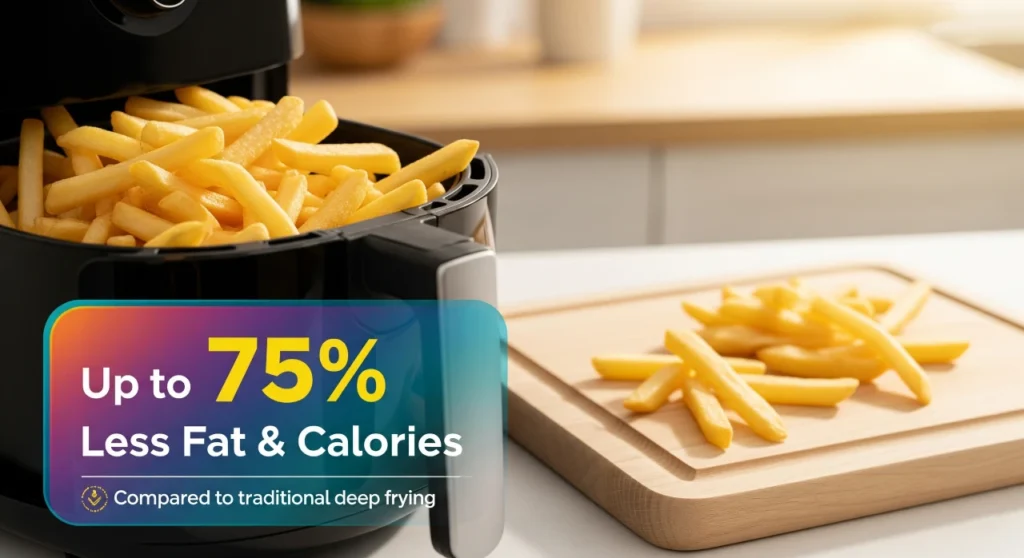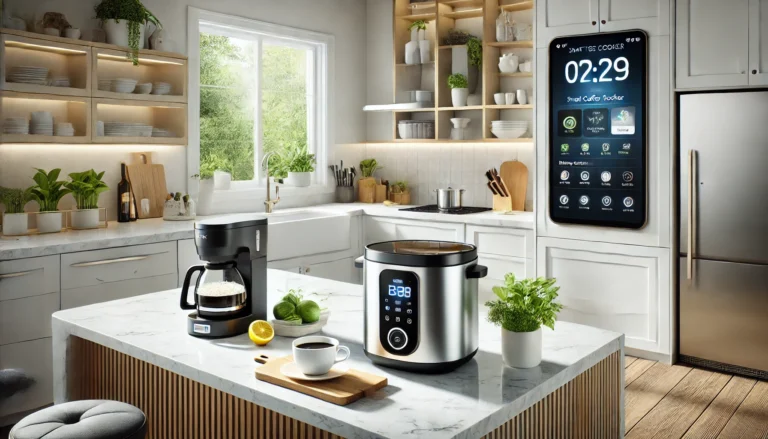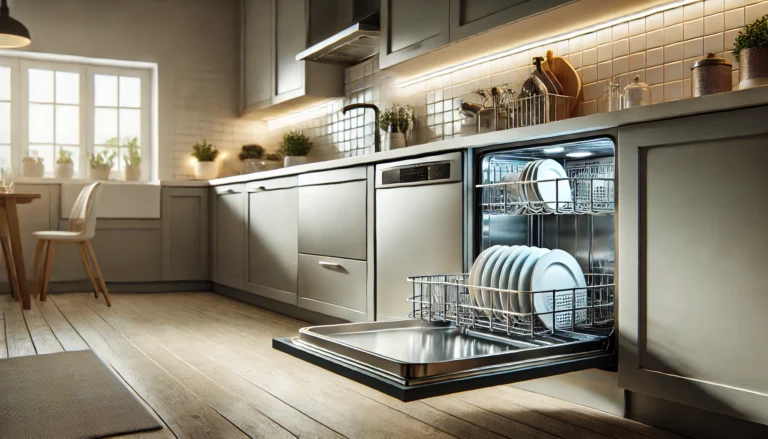Who doesn’t love the satisfying crunch of perfectly fried food? I’ll admit it—I used to be that person who couldn’t resist golden French fries or crispy fried chicken, even when I was trying to eat healthier. The guilt was real, but so was my craving for that addictive texture.
Then I discovered air fryers, and honestly, I was skeptical at first. How could hot air possibly create the same crispy magic as a vat of bubbling oil? After months of experimenting (and plenty of trial and error in my own kitchen), I’ve learned the fascinating science behind why air fryers actually work—and how they can slash calories without sacrificing the foods we love.
If you’ve been wondering whether air fryers live up to the hype, or you’re curious about the actual science behind healthier “fried” foods, you’re in for a treat. Let me share what I’ve discovered about this game-changing kitchen appliance.
What Actually Happens When You Deep Fry Food?
Let me paint a picture of what’s really going on in that bubbling oil. I used to think deep frying was just about heat, but there’s actually a fascinating two-step process happening every time you drop food into hot oil.
First, that intense heat (usually around 350-375°F) works like a tiny steam engine on your food’s surface. Water molecules get so hot they turn to steam and escape, leaving behind tiny pockets that create that crispy texture we all crave. It’s like nature’s own version of bubble wrap!
But here’s where things get interesting (and a bit scary for our waistlines): while all that moisture is escaping, the oil is rushing in to fill those empty spaces. Your innocent potato or piece of chicken literally becomes a sponge, soaking up oil the entire time it’s cooking.
I remember the first time I actually measured this. When I made homemade French fries the traditional way, I watched in horror as my 110-calorie medium potato transformed into a 365-calorie serving of fries. That’s more than tripling the calories! The potato didn’t change—it just became a vehicle for absorbing cooking oil.
How Do Air Fryers Create Crispy Food Without Oil?
This is where air fryers get really clever, and honestly, it’s almost like kitchen magic once you understand it. Instead of dunking your food in oil, air fryers use something called “rapid air circulation technology.” Basically, they’re like tiny hurricanes of superheated air moving around your food at incredible speeds—we’re talking up to 40 miles per hour!
Here’s what blew my mind when I first learned this: that moving hot air can actually create the same golden-brown crispiness as oil. It all comes down to something scientists call the “Maillard reaction,” which is just a fancy way of saying “the browning process that makes food look and taste amazing.”
You’ve experienced the Maillard reaction before, even if you didn’t know it had a name. It’s what gives bread its golden crust, what creates that perfect sear on a steak, and yes, what makes fried foods turn that beautiful golden brown. The incredible part? Air fryers can trigger this same reaction using superheated air instead of oil.
When I tried my first batch of air fryer chicken wings, I couldn’t believe they came out crispy and golden without swimming in oil. The secret was that rushing hot air working overtime to remove moisture from the surface while triggering all those delicious browning reactions.
The Real Numbers: How Many Calories Can You Actually Save?
Okay, let’s talk about the numbers that made me fall in love with my air fryer. When I started tracking this stuff, I was shocked at how much of a difference the cooking method actually made.
Here’s the deal with traditional deep frying: your food typically absorbs anywhere from 8% to 25% of its weight in oil. Since each tablespoon of oil packs about 120 calories, we’re talking about some serious caloric additions here.
Let me give you a real example that made my jaw drop. When I make French fries the traditional way, each serving soaks up about 2-3 tablespoons of oil. That’s 240-360 calories from fat alone—before we even count the potato! With my air fryer, I use maybe a teaspoon of oil (just a light spray), which adds only 40 calories.
That’s not a typo. We’re talking about an 80-90% reduction in added fats, which translates directly to massive calorie savings. Since fat contains 9 calories per gram (more than double what protein or carbs have), cutting back on oil absorption is like finding a calorie-cutting goldmine.
I started keeping a little notebook of my comparisons, and here’s what I found:
- Air fryer chicken wings: 40% fewer calories than deep-fried
- Air fryer donuts: 70% fewer calories (yes, you can make donuts in an air fryer!)
- Air fryer zucchini fries: 85% fewer calories than the deep-fried version
When I did the math on just replacing deep-fried fries with air-fried ones three times a week, I realized I could save over 30,000 calories per year. That’s equivalent to about 9 pounds of body weight!
Why Does Air Frying Work So Well? The Science Made Simple
You might be wondering (like I did) how air fryers create that perfect crispy texture with barely any oil. The answer really comes down to understanding what makes food crispy in the first place.
Here’s the thing: crispiness isn’t actually about oil soaking into your food. It’s about removing moisture from the surface. Traditional frying achieves this moisture removal as a side effect of oil absorption, but air frying goes straight to the source.
Think of it like this: imagine trying to dry your hair. You could let it air dry naturally (which takes forever), or you could use a blow dryer. The moving air from the blow dryer pulls moisture away much faster and more efficiently. That’s exactly what’s happening in your air fryer—the rapid air movement yanks moisture away from your food’s surface faster than it can be replaced from the inside.
I love this comparison because it really clicked for me. The air fryer creates that perfect crispy shell by dehydrating the outer layer while keeping the inside moist and tender. It’s like having the best of both worlds: the texture we crave without drowning everything in oil.
What’s even cooler is that this moving air is actually more efficient at heat transfer than still oil. The convection effect means every surface of your food gets hit with consistent, intense heat, which is why air fryer foods often cook faster than traditional methods.
Bonus Health Benefits You Probably Didn’t Know About
While the calorie savings got me interested in air fryers, I discovered some unexpected health perks that made me love them even more.
First up: nutrient preservation. I had no idea that traditional deep frying’s high temperatures and long cooking times actually destroy heat-sensitive vitamins like vitamin C and some B vitamins. Since air fryers cook faster and with more controlled temperatures, more of those good-for-you nutrients stick around.
But here’s something that really opened my eyes: when you use oil repeatedly for deep frying (like restaurants do), some pretty nasty stuff starts forming. We’re talking trans fats and oxidized compounds that can contribute to inflammation and heart disease. With air frying, since you’re using minimal oil and it’s fresh every time, you completely avoid this problem.
I also love that air fryers are just cleaner to use. No more dealing with large amounts of hot oil, no splatter burns, and definitely no lingering deep-fry smell that takes days to air out of your kitchen. As someone who’s been burned by spattering oil more times than I care to admit, this alone was worth the switch.
Getting the Best Results: Temperature Tips from My Kitchen
After cooking with my air fryer for over a year, I’ve learned that temperature really matters for maximizing both taste and health benefits. Most air fryers work between 200-400°F, but I’ve found the sweet spot for most foods is 350-375°F.
This temperature range is hot enough to get that beautiful golden-brown Maillard reaction we talked about, but not so hot that it starts breaking down nutrients or burning your food. I learned this the hard way when I cranked up the heat too high on my first attempt at air fryer vegetables—they turned into charcoal!
For more delicate foods or anything with natural sugars (like sweet potato fries), I stick to 300-325°F to prevent burning. For heartier items like chicken wings or thick-cut fries, 375-400°F gives me that perfect crispy exterior.
Pro tip I wish someone had told me earlier: preheating your air fryer for 2-3 minutes makes a huge difference in getting that initial crispy sear.
Let’s Be Real: When Air Fryers Don’t Work Magic
I want to be completely honest with you because I hate it when blog posts promise miracle results without mentioning the downsides. Air fryers are amazing, but they’re not perfect for everything.
They work best with foods that naturally have some oil content or benefit from getting crispy on the outside. If you’re trying to air fry something super lean (like plain white fish) or really wet vegetables, you might need to add a tiny bit of oil to get good results.
Also, while air fryers do an incredible job replicating certain fried foods—especially anything that should be crispy outside and tender inside—they can’t perfectly recreate every single aspect of deep frying. There are some unique flavors and textures that only come from oil immersion, and I’d be lying if I said air frying was identical.
The good news? For most of us trying to eat healthier while still enjoying satisfying food, air fryers hit that sweet spot of “close enough to the real thing” while being way better for our health goals.
Why This Matters for Your Healthy Eating Journey
After using my air fryer regularly for more than a year, I can honestly say it’s been a game-changer for my relationship with food. Before, I felt like I had to choose between foods I enjoyed and foods that were good for me. The air fryer eliminated that false choice.
This isn’t just about cutting calories (though that’s awesome). It’s about removing one of the biggest barriers to healthy eating: the belief that nutritious food has to be boring or unsatisfying. When you can make crispy sweet potato fries, golden chicken tenders, or even “fried” pickles that actually taste great, healthy eating stops feeling like a punishment.
I’ve found that understanding the science behind why air fryers work has made me a better cook overall. Knowing that crispiness comes from moisture removal rather than oil absorption has changed how I think about cooking methods in general.
The Bottom Line: Air Fryers and Your Health Goals
Every time you hear that satisfying sizzle coming from your air fryer, you’ll know exactly what’s happening: superheated air is rapidly removing moisture from your food’s surface, creating that perfect crispy texture while leaving the calorie-heavy oil where it belongs—in the bottle.
The science is clear: air fryers can dramatically reduce the calories in your favorite “fried” foods without sacrificing the flavors and textures you love. Whether you’re trying to lose weight, eat healthier, or just enjoy guilt-free comfort food, air fryers offer a practical solution backed by solid science.
That’s not just convenient cooking—that’s technology working in favor of your health goals. And honestly, that’s something I can get excited about every single time I use my air fryer.
Ready to start air frying? The best part is that once you understand the science, you can experiment with confidence, knowing that you’re creating healthier versions of your favorite foods without compromise.




